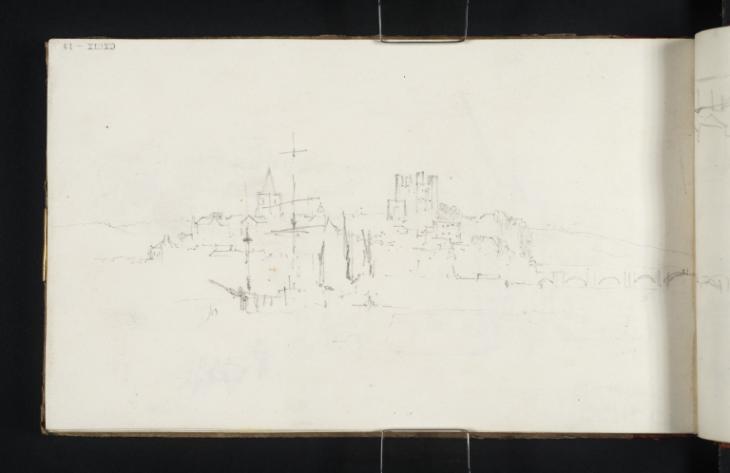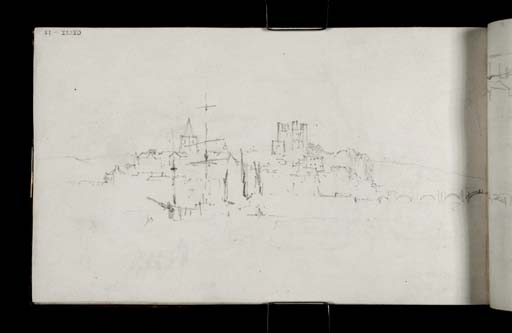Joseph Mallord William Turner Rochester Castle and Bridge, from the North c.1821
Image 1 of 2
Joseph Mallord William Turner,
Rochester Castle and Bridge, from the North
c.1821
Joseph Mallord William Turner 1775–1851
Folio 18 Recto:
Rochester Castle and Bridge, from the North c.1821
D17394
Turner Bequest CXCIX 18
Turner Bequest CXCIX 18
Pencil on white wove paper, 112 x 190 mm
Partial watermark ‘nard | 20’
Stamped in black ‘CXCIX – 18’ top left, upside down
Partial watermark ‘nard | 20’
Stamped in black ‘CXCIX – 18’ top left, upside down
Accepted by the nation as part of the Turner Bequest 1856
References
1909
A.J. Finberg, A Complete Inventory of the Drawings of the Turner Bequest, London 1909, vol.I, p.608, CXCIX 18, as ‘Rochester Castle and Bridge from the river, &c.’.
1910
Alexander J. Finberg, Turner’s Sketches and Drawings, London 1910, pp.108–9, pl.LXII(a).
1980
Michael Spender and Malcolm Fry, Turner at the Bankside Gallery: Catalogue of an Exhibition of Drawings & Water-colours of British River Scenes from the British Museum, exhibition catalogue, Bankside Gallery, London 1980, p.120 under no.55.
1991
Ian Warrell, Turner: The Fourth Decade: Watercolours 1820–1830, exhibition catalogue, Tate Gallery, London 1991, p.31 under no.11.
Made with the sketchbook inverted according to its foliation, this detailed drawing of Rochester encompasses the Cathedral at left, the Castle at centre, and the Bridge towards bottom right. The latter extends across the gutter, and slightly onto folio 27 verso (D17393). A vessel sits in the river in the foreground, its masts cutting across the urban sprawl behind.
It is widely agreed that this is one of a group of sketches which informed the watercolour Rochester, on the River Medway, of 1822 (Tate D18156; Turner Bequest CCVIII W),1 which was engraved by Thomas Lupton for the Rivers of England series and published in January 1824 (Tate impressions T06370, T04796–T04798). Ian Warrell groups this page alongside folios 10 recto, 18 verso, and 19 recto (D17381, D17395, and D17396) as those which directly influenced the finished composition.2
Finberg elaborates this drawing with a narrative of Turner’s process of composition. He describes earlier sketches in the book as direct records of topographic features, which here begin to morph into a group with ‘systematic unity’.3 Speaking of this prospect specifically, he expresses that, ‘the exact position of the mast of the foreground vessel is the dominant factor, – the way it unites the lines described by the silhouette of the castle and the trees sloping down to the bridge, bringing the curves to a focus, as it were, and providing a rigid base for them to spring from again’.4 In spite of this shift towards the poetic amalgamation of concrete elements, Finberg recollects that he has never discovered a drawing in Turner’s sketchbooks which was not changed in some way before it was committed to watercolour.5 Indeed, Warrell notes that although some of these preparatory sketches stretch to 380 mm wide, the watercolour contracts the view into a much smaller space, measuring some 200 mm.6
Turner may have nurtured a nostalgic relationship with Rochester. 7 It supplied the subject for one of his earliest oil paintings, which observed fishing boats below the castle (Tate impressions: T05881–T05882).8 The city and its position on the Medway are certainly given a significant degree of attention in this sketchbook. Finberg articulates that, ‘before Turner shut up his book he had made over a dozen skeleton designs [of Rochester], which he had only to clothe in colour and light and shade to develop into beautiful pictures’.9 For further studies within these pages, see folios 7 recto, 10 recto, 17 verso, 18 verso, 19 recto, 20 recto and verso, 21 recto, 23 recto, 27 verso, 28 recto, 47 verso, 59 recto, and 90 recto (D17376, D17381, D17393, D17395–D17396, D17398–D17400, D17404, D17410–D17411, D17446, D17462, D17506). Also see the Folkestone sketchbook in this section, of about 1821–2, particularly the entry for folio 6 verso (Tate D17217; Turner Bequest CXCVIII 6a).
Elsewhere, see Tate D00117 and D00180 (Turner Bequest VIII C, XVII E), possibly from about 1793; Tate D00158–D00159 and D01109 (Turner Bequest XV B, C, XXXVI O) from 1794; the River and Margate sketchbook of around 1805–9 (Tate D06400, D06405, D06407, D06449–D06450, D06480, D06482; Turner Bequest XCIX 25a, 28, 29, 53a–54, 69a, 70a); and the Gravesend and Margate sketchbook of about 1832 (Tate D27352–D27353, and D27356; Turner Bequest CCLXXIX 45a–46, and 47a). Also see three watercolour studies (Tate D25231, D25286, D25474; Turner Bequest CCLXIII 109, 164, 351) and Rochester Castle from the River of about 1793 (Tate D00160; Turner Bequest XV D). Casting a wider net, see also Rochester of 1795 (Manchester Art Gallery).10
Technical notes:
This page has been cut from the sketchbook and pasted back in. There is a single neat join close to the gutter.
Maud Whatley
January 2016
How to cite
Maud Whatley, ‘Rochester Castle and Bridge, from the North c.1821 by Joseph Mallord William Turner’, catalogue entry, January 2016, in David Blayney Brown (ed.), J.M.W. Turner: Sketchbooks, Drawings and Watercolours, Tate Research Publication, February 2017, https://www


